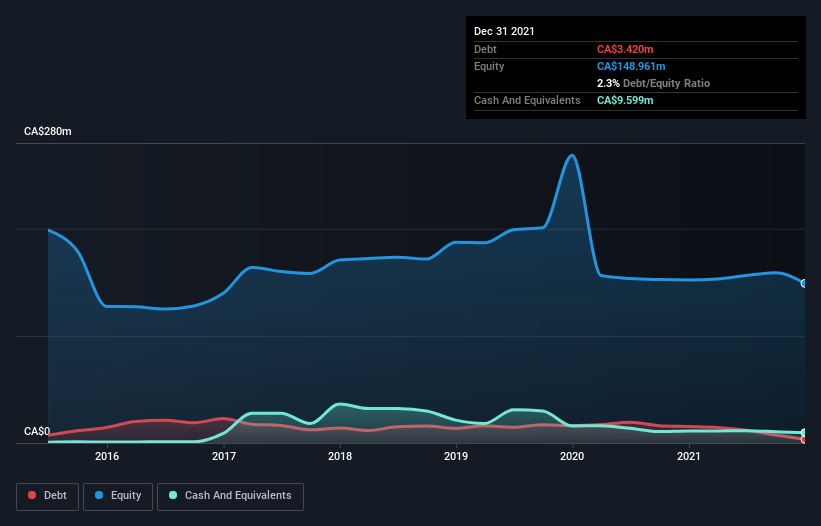Questerre Energy (TSE:QEC) Seems To Use Debt Quite Sensibly
Legendary fund manager Li Lu (who Charlie Munger backed) once said, 'The biggest investment risk is not the volatility of prices, but whether you will suffer a permanent loss of capital.' So it might be obvious that you need to consider debt, when you think about how risky any given stock is, because too much debt can sink a company. Importantly, Questerre Energy Corporation (TSE:QEC) does carry debt. But the real question is whether this debt is making the company risky.
What Risk Does Debt Bring?
Debt is a tool to help businesses grow, but if a business is incapable of paying off its lenders, then it exists at their mercy. In the worst case scenario, a company can go bankrupt if it cannot pay its creditors. However, a more usual (but still expensive) situation is where a company must dilute shareholders at a cheap share price simply to get debt under control. Having said that, the most common situation is where a company manages its debt reasonably well - and to its own advantage. When we examine debt levels, we first consider both cash and debt levels, together.
View our latest analysis for Questerre Energy
What Is Questerre Energy's Net Debt?
The image below, which you can click on for greater detail, shows that Questerre Energy had debt of CA$3.42m at the end of December 2021, a reduction from CA$15.4m over a year. But on the other hand it also has CA$9.60m in cash, leading to a CA$6.18m net cash position.
How Healthy Is Questerre Energy's Balance Sheet?
The latest balance sheet data shows that Questerre Energy had liabilities of CA$11.8m due within a year, and liabilities of CA$23.5m falling due after that. On the other hand, it had cash of CA$9.60m and CA$4.02m worth of receivables due within a year. So its liabilities total CA$21.7m more than the combination of its cash and short-term receivables.
While this might seem like a lot, it is not so bad since Questerre Energy has a market capitalization of CA$79.3m, and so it could probably strengthen its balance sheet by raising capital if it needed to. But we definitely want to keep our eyes open to indications that its debt is bringing too much risk. Despite its noteworthy liabilities, Questerre Energy boasts net cash, so it's fair to say it does not have a heavy debt load!
It was also good to see that despite losing money on the EBIT line last year, Questerre Energy turned things around in the last 12 months, delivering and EBIT of CA$99m. When analysing debt levels, the balance sheet is the obvious place to start. But you can't view debt in total isolation; since Questerre Energy will need earnings to service that debt. So when considering debt, it's definitely worth looking at the earnings trend. Click here for an interactive snapshot.
Finally, a company can only pay off debt with cold hard cash, not accounting profits. Questerre Energy may have net cash on the balance sheet, but it is still interesting to look at how well the business converts its earnings before interest and tax (EBIT) to free cash flow, because that will influence both its need for, and its capacity to manage debt. In the last year, Questerre Energy created free cash flow amounting to 9.5% of its EBIT, an uninspiring performance. For us, cash conversion that low sparks a little paranoia about is ability to extinguish debt.
Summing up
Although Questerre Energy's balance sheet isn't particularly strong, due to the total liabilities, it is clearly positive to see that it has net cash of CA$6.18m. So we are not troubled with Questerre Energy's debt use. The balance sheet is clearly the area to focus on when you are analysing debt. But ultimately, every company can contain risks that exist outside of the balance sheet. For instance, we've identified 3 warning signs for Questerre Energy (1 can't be ignored) you should be aware of.
At the end of the day, it's often better to focus on companies that are free from net debt. You can access our special list of such companies (all with a track record of profit growth). It's free.
Have feedback on this article? Concerned about the content? Get in touch with us directly. Alternatively, email editorial-team (at) simplywallst.com.
This article by Simply Wall St is general in nature. We provide commentary based on historical data and analyst forecasts only using an unbiased methodology and our articles are not intended to be financial advice. It does not constitute a recommendation to buy or sell any stock, and does not take account of your objectives, or your financial situation. We aim to bring you long-term focused analysis driven by fundamental data. Note that our analysis may not factor in the latest price-sensitive company announcements or qualitative material. Simply Wall St has no position in any stocks mentioned.

 Yahoo Finance
Yahoo Finance 
